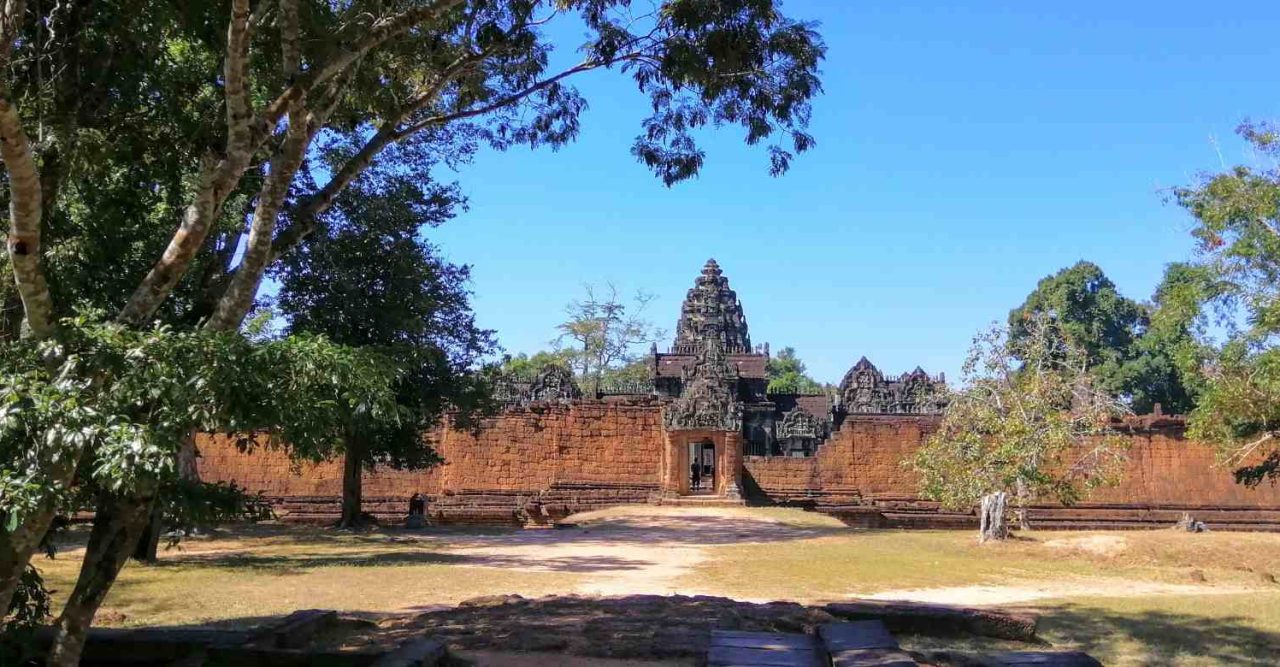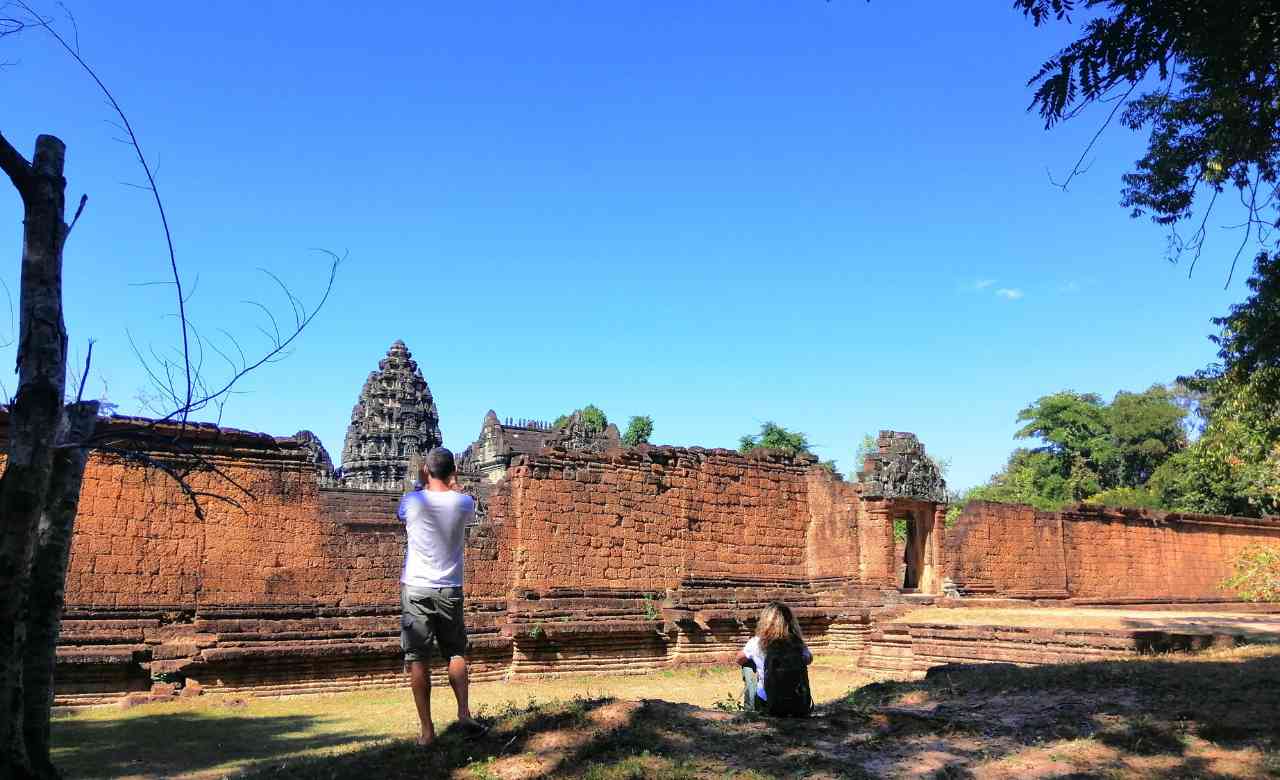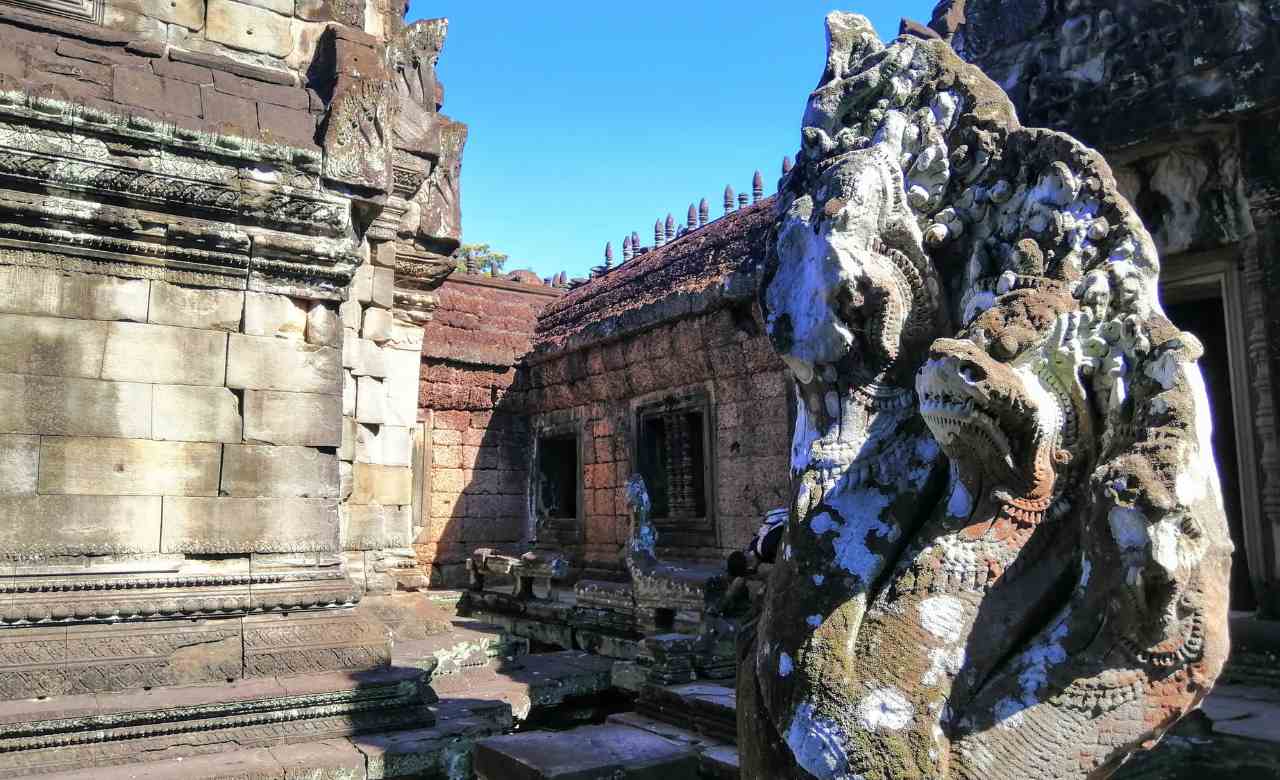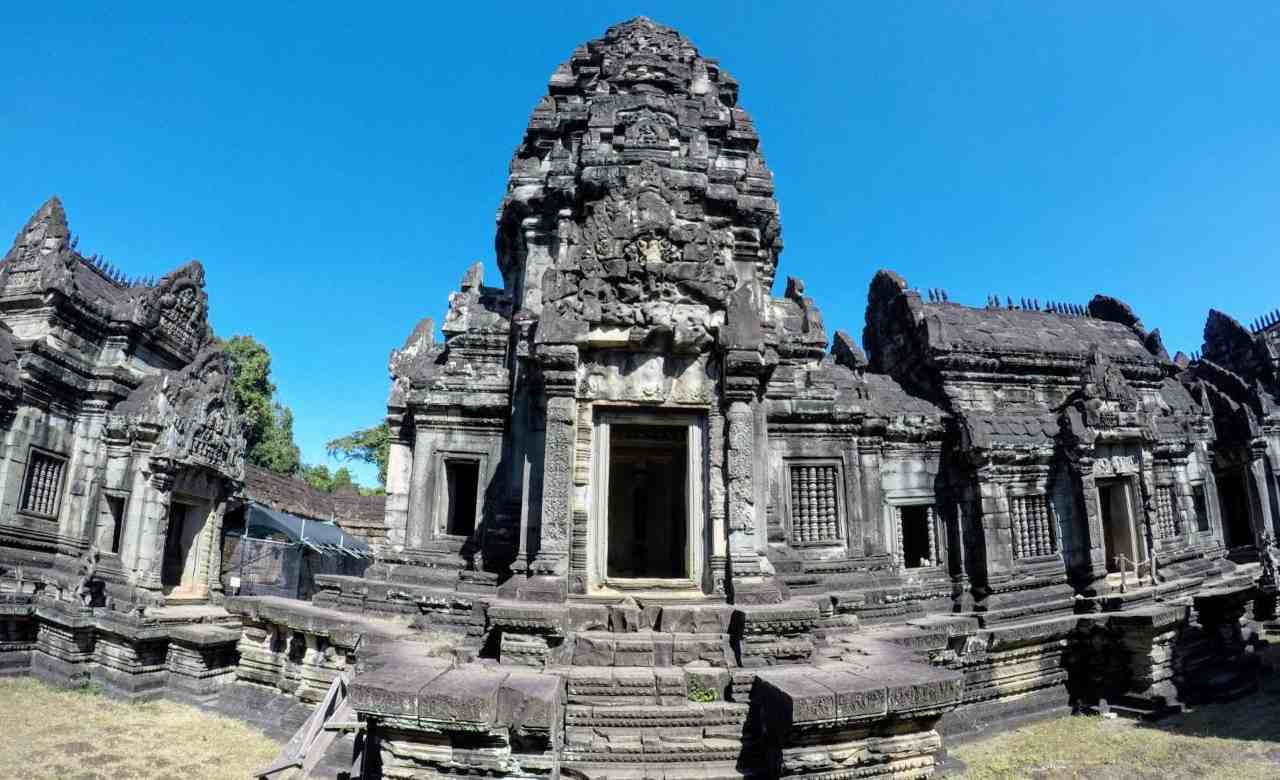Introduction
Welcome to the journey of a lifetime that takes you back to the 12th century, to the heart of the Angkor era. Picture this: you’re standing before a colossal structure, a testament to the grandeur of a bygone era. This is Banteay Samre Temple, a monument that has withstood the test of time, a beacon of Cambodian history.
Why is this temple so important, you ask?
Well, it’s not just a temple; it’s a time capsule, preserving the rich cultural heritage of Cambodia. It’s a testament to the architectural prowess of the Khmer Empire and a symbol of the people’s spiritual beliefs.
The Origins of Banteay Samre
Now, let’s rewind the clock and delve into the origins of this architectural marvel. Picture a king, Suryavarman II, a visionary who dreamt of a temple that would stand the test of time. Under his reign, the conception of Banteay Samre Temple took place. It’s like the first brush stroke on a blank canvas, the beginning of a masterpiece.
But the story doesn’t end there. The temple was passed on to Suryavarman’s cousin and then to Jayavarman VII. Imagine a relay race, where the baton is passed from one runner to the next.
With their religious persuasions, each ruler added their unique touch to the temple.
Suryavarman II, a devout Hindu, initiated the construction of the temple dedicated to Vishnu. His cousin, a follower of Mahayana Buddhism, added Buddhist elements to the temple. Finally, Jayavarman VII, a follower of Theravada Buddhism, left his mark on the temple. It’s like a beautiful tapestry woven with threads of diverse beliefs, creating a unique spiritual ambiance.
So, are you ready to explore this architectural marvel? Are you prepared to walk the same paths as ancient kings and priests, to stand in awe of the intricate carvings, and to feel the spiritual energy that permeates Banteay Samre?
If so, pack your bags and join us on our Private Angkor Wat Special Tour or our Beng Mealea Temple Tour Experience. After all, history isn’t just something you read in a book; it’s something you experience, feel, and remember.
Let’s Explore all the Relevant Content of this Article and the Key Takeaways
| Relevant | Article Takeaway |
|---|---|
| Angkor era | Banteay Samre is a testament to the grandeur of the Angkor era, showcasing its architectural prowess and spiritual significance. |
| Suryavarman II | The temple was built during the reign of Suryavarman II, reflecting his influence and the cultural dynamics of his time. |
| Jayavarman VII | The temple also saw influences during the reign of Jayavarman VII, adding to its historical significance. |
| Buddhist influence | The temple showcases a unique blend of Hindu and Buddhist elements, reflecting the religious diversity of the Khmer Empire. |
| Hindu influence | The temple was originally dedicated to the Hindu god Vishnu, highlighting the Hindu influence in its design and spiritual practices. |
| Khmer Empire | Banteay Samre stands as a symbol of the architectural and spiritual achievements of the Khmer Empire. |
| Naga guardians | The Naga guardians are a key feature of the temple, representing protection and divine energy. |
| Maurice Glaize | Maurice Glaize played a significant role in the restoration of the temple, preserving its historical and cultural integrity. |
| Temple restoration | The restoration efforts have helped maintain the temple, allowing future generations to experience its grandeur and spiritual energy. |
| Looting of statues | The looting of statues, including the lost statue, is a tragic part of the temple’s history, highlighting the need for preservation efforts. |
| Sacred spaces | The sacred spaces within the temple offer a serene and tranquil ambiance, providing a unique spiritual experience for visitors. |
| Preservation efforts | Supporting preservation efforts is crucial in maintaining the temple and protecting our cultural heritage. |
| Cambodian history | Banteay Samre is a significant part of Cambodian history, offering insights into the Angkor era and the Khmer Empire. |
| Architectural prowess | The temple showcases the architectural prowess of the Khmer artisans, from its grand structure to its intricate carvings. |
| Spiritual experience | Visiting Banteay Samre is a spiritual experience, from exploring the sacred spaces to feeling the spiritual energy that permeates the temple. |
| Temple visit | A visit to the temple is a journey back in time, offering a glimpse into the past and a unique cultural experience. |
| Sarcophagus | The sarcophagus is a key feature of the temple, adding to its spiritual significance and historical intrigue. |
| Lost statue | The lost statue is a tragic part of the temple’s history, serving as a reminder of the vulnerability of our cultural heritage. |
| High priests | The high priests played a crucial role in the temple’s spiritual practices, adding to its religious significance. |
| Ancient deities | The temple is home to carvings of ancient deities, reflecting the religious beliefs and practices of the Khmer people. |
| Spiritual energy | The spiritual energy that permeates the temple offers a unique experience, from the tranquility of the sacred spaces to the awe-inspiring sunrise and sunset. |
| Historical significance | Banteay Samre holds historical significance, from its origins in the Angkor era to its role in the Khmer Empire. |
| Cultural heritage | The temple is a part of our cultural heritage, a testament to the grandeur of the Angkor era and the spiritual beliefs of the Khmer people. |
For a deeper understanding:
The Architectural Marvel of Banteay Samre
Let’s take a moment to appreciate the architectural marvel that is the Banteay Samre Temple. First, picture a medieval fort, with its imposing walls and intricate doorways. Now, imagine that fort, not in Europe, but in the heart of Cambodia. That’s Banteay Samre for you.
The temple’s structure is a testament to the architectural prowess of the Khmer Empire. The mighty walls, the intricate carvings, the towering spires, each element is a piece of the puzzle that makes up this architectural marvel. It’s like stepping into a fortress, but you’re greeted by ancient deities instead of soldiers.
And let’s not forget the doorways. Each doorway is an intricate piece of art, adorned with carvings that tell tales of the gods and goddesses, of mythical creatures and legendary battles. It’s like walking through a gallery of ancient art, each piece telling its own story.
The Heart of the Temple: The Sarcophagus
At the heart of the temple lies a sarcophagus, a sacred space that likely served as the final resting place for a multitude of individuals. Picture a cathedral in England, where kings are laid at our feet. The same reverence was likely bestowed upon this sacred space, a testament to the temple’s spiritual significance.
The sarcophagus is located in the central sanctuary, a place reserved for the most sacred rituals and ceremonies. It’s like the heart of the temple, pumping spiritual energy to every corner of the structure.
So, are you ready to explore this architectural marvel?
Are you prepared to walk through the intricate doorways, to stand in awe of the mighty walls, and to feel the spiritual energy that emanates from the sarcophagus?
Private Angkor Wat special tour – Angkor Guided Tour with Phnom Bok Sunset and much more
The Guardians of the Temple: The Naga
The Naga, a mythical serpent creature, plays a significant role in the Banteay Samre temple.
These divine beings are believed to be the protectors of the temple, guarding it from evil spirits. As you walk through the temple, you’ll notice the intricate carvings of the Naga on the balustrades, their bodies coiled and heads raised, ready to strike.
The craftsmanship of the Khmer artisans is evident in the detailed carvings of the Naga.
Each scale on the serpent’s body is meticulously carved, showcasing the artisans’ attention to detail and their profound understanding of the mythical creature.
The Naga carvings are not just mere decorations; they are a testament to the Khmer’s deep-rooted belief in these divine beings and their role in protecting the sacred temple.
The Restoration of Banteay Samre
The restoration of the Banteay Samre temple is a story of resilience and dedication.
Maurice Glaize, a renowned French architect and conservator, played a pivotal role in the restoration process. Under his guidance, the temple was carefully restored to its former glory, preserving its historical and cultural significance.
Today, the temple stands as a testament to the grandeur of the Angkor period and the meticulous restoration work carried out by Glaize and his team.
Despite the ravages of time and nature, the temple continues to captivate visitors with its intricate carvings, grand architecture, and the serene ambiance that pervades its premises.
The restoration of the Banteay Samre temple is not just about preserving a historical monument; it’s about keeping alive the rich cultural heritage of the Khmer civilization. As you walk through the temple, you can’t help but marvel at the resilience of this ancient structure and the painstaking efforts taken to restore it.
For more detailed information about the temple, you can visit this site. It provides a comprehensive overview of the Banteay Samre temple, including its history, architecture, and significance in the Angkor period.
Remember, visiting the Banteay Samre temple is not just about witnessing an architectural marvel; it’s about stepping back in time and immersing yourself in the rich cultural heritage of the Khmer civilization. So, take your time to explore the temple, soak in its serene ambiance, and let its ancient walls tell you the tales of a bygone era.
The Tragedy of the Temple: The Lost Statue
Every tale has its share of tragedy, and the story of Banteay Samre is no different. But, amidst the grandeur and the glory, there lies a tale of loss – the tale of the lost statue.
Once a magnificent piece of art, the statue was a significant part of the temple. It was more than just a piece of stone; it was a symbol of the temple’s spiritual significance, a beacon of the religious beliefs of the people who worshipped there. But alas, the statue is no more. It was lost to the hands of looters, a tragic loss that left a void in the heart of the temple.
The impact of looting on the temple is profound. It’s like a wound that never fully heals. The loss of the statue robbed the temple of its spiritual symbol and stripped it of a piece of its history. It’s a stark reminder of the vulnerability of our cultural heritage and the need to protect it.
The Sacred Spaces within the Temple
Despite the loss, the temple still holds its charm, thanks in part to the sacred spaces within its walls. These spaces, once the hub of spiritual activities, continue to exude a serene and tranquil ambiance.
As you walk through the temple, you’ll come across these sacred spaces – the sanctuaries, the libraries, the meditation halls. Each space’s unique architectural style and spiritual significance offers a unique experience. It’s like walking through a labyrinth of tranquility, each turn revealing a new facet of the temple’s spiritual essence.
The experience of being in these spaces is nothing short of spiritual. It’s like being in a bubble of tranquility, insulated from the chaos of the outside world. The serene ambiance, the spiritual energy, the sense of history – it all comes together to create a humbling and uplifting experience.
The Call to Experience Banteay Samre
Have you ever felt the call of the unknown, the allure of history, the charm of a bygone era? If so, Banteay Samre is calling you. This temple, a testament to the grandeur of the Angkor era, is not just a monument; it’s an experience, a journey back in time.
Imagine walking through the temple’s grand entrance, the ancient stone beneath your feet, the towering spires above you. As you explore the temple, you’ll come across intricate carvings, each telling a tale of gods and goddesses, of mythical creatures and legendary battles. It’s like walking through a living museum, each artifact whispering tales of a bygone era.
But the experience is not just about the past but also the present.
- It’s about the tranquility that pervades the temple, the spiritual energy that permeates every corner, the sense of peace that engulfs you as you explore the sacred spaces.
- It’s about the awe-inspiring sunrise that bathes the temple in a golden hue, the serene sunset that casts long shadows on the ancient walls.
- It’s about feeling part of something larger than life, something timeless, something eternal.
So, heed the call. Experience Banteay Samre. Let the ancient walls tell you their tales, let the sacred spaces fill you with tranquility, let the spiritual energy rejuvenate your soul.
Supporting the Preservation of Banteay Samre
The preservation of Banteay Samre is not just about maintaining a historical monument; it’s about preserving our cultural heritage, our link to the past. It’s about ensuring that future generations get to experience the grandeur of the Angkor era, the spiritual energy of the temple, the tranquility of the sacred spaces.
But preservation is not a one-man job; it’s a collective effort, a responsibility that we all share. And there are many ways you can contribute to this effort.
You can spread awareness about the importance of preserving our cultural heritage, you can volunteer in restoration projects, you can donate to organizations that work towards the preservation of historical monuments.
Remember, every little effort counts. Every tweet, every blog post, every donation, every hour spent volunteering – it all adds up. It’s like a ripple in a pond; a small pebble can create far and wide waves.
So, let’s join hands in preserving Banteay Samre. Let’s ensure that this architectural marvel, this testament to the grandeur of the Angkor era, continues to stand tall and proud, telling its tales to generations to come.
Banteay Samre Temple Location
Banteay Samre Temple FAQ
1. What was the Banteay Samre temple used for?
Banteay Samre was more than just a temple; it was a spiritual hub, a place of worship, a symbol of the divine.
The temple was devoted to the Hindu god Vishnu and was built during the reigns of Suryavarman II and Yasovarman II in the early 12th century.
It was a place where the Khmer people practiced their religious rituals, sought spiritual guidance, and paid homage to their gods.
Imagine a place buzzing with spiritual energy, a place where the mundane meets the divine. That’s what Banteay Samre was – a bridge between the earthly and the ethereal.
2. What is the mysterious temple in Cambodia?
When we talk about mysterious temples in Cambodia, the first name that comes to mind is Ta Prohm.
Unlike other temples, Ta Prohm has been left in much the same condition in which it was found, with trees growing out of the ruins and the jungle surroundings creating a mystical ambiance.
But let’s not forget Banteay Samre. With its intricate carvings, grand architecture, and serene ambiance, Banteay Samre holds its own share of mysteries. It’s like a puzzle waiting to be solved, a mystery waiting to be unraveled.
3. What is the largest temple in the world in Cambodia?
The title of the largest temple in the world goes to none other than Angkor Wat. This architectural marvel, spread over 400 acres, is a testament to the grandeur of the Khmer Empire.
But while Angkor Wat may be the largest, Banteay Samre, with its unique architecture and spiritual significance, holds its own charm. It’s like comparing a bustling city with a serene countryside; both have their unique allure.
4. What is the most famous incident temple complex in Cambodia?
The most famous temple complex in Cambodia is undoubtedly the Angkor Wat complex. With its iconic lotus-bud towers, intricate carvings, and vast scale, Angkor Wat is a sight to behold.
Nestled within the Angkor complex is Banteay Samre, a gem that often goes unnoticed. With its unique blend of Hindu and Buddhist elements, tranquil ambiance, and rich history, Banteay Samre is a must-visit for anyone exploring the Angkor complex. It’s like finding a hidden treasure in a treasure trove.
Conclusion
As we reach the end of our journey through Banteay Samre, let’s take a moment to reflect on the key points we’ve discussed. We’ve delved into the origins of the temple, marvelled at its architectural grandeur, and explored its sacred spaces. We’ve learned about the lost statue, the guardians of the temple, and the efforts to restore and preserve this historical monument.
Banteay Samre is more than just a temple; it’s a testament to the grandeur of the Angkor era, a symbol of the spiritual beliefs of the Khmer people, a beacon of our cultural heritage. It’s a place where history comes alive, the past meets the present, and the mundane meets the divine.
But Banteay Samre is not just about the past; it’s about the present too. It’s about the tranquility that pervades the temple, the spiritual energy that permeates every corner, the sense of peace that engulfs you as you explore the sacred spaces.
- It’s about the awe-inspiring sunrise that bathes the temple in a golden hue, the serene sunset that casts long shadows on the ancient walls.
- It’s about feeling part of something larger than life, something timeless, something eternal.
So, as we conclude our journey, let’s remember the importance and beauty of Banteay Samre. Let’s remember that every stone, every carving, every corner of the temple has a tale to tell, a tale of gods and goddesses, of kings and queens, of myths and legends.
And let’s remember that these tales are not just a part of our history; they are a part of our identity and who we are.
In the end, visiting Banteay Samre is not just about witnessing an architectural marvel.
- It’s about experiencing a slice of history, a piece of our cultural heritage.
- It’s about stepping back in time and immersing ourselves in the rich cultural tapestry of the Khmer civilization.
- And it’s about carrying forward this legacy and heritage for generations to come.
The Facts about Banteay Samre Temple
The Temple’s Origins: A Mixed Pedigree
Banteay Samre was initially conceived by Suryavarman II, passed to his cousin, and then to Jayavarman VII. This succession of rulers, each with their own religious persuasions, resulted in a temple that showcases both Buddhist and Hindu influences. It’s like a beautiful tapestry woven with threads of diverse beliefs, creating a unique spiritual ambiance.
The Temple’s Architecture: A Medieval Fort
The temple’s imposing structure resembles a medieval fort, a protective shield for the treasures and villagers that once thrived here. The mighty walls and intricate doorways are a testament to the architectural prowess of the Khmer Empire. It’s like stepping into a fortress, but instead of soldiers, you’re greeted by ancient deities.
The Temple’s Heart: A Sacred Space
At the heart of the temple lies a sarcophagus, a sacred space that likely served as the final resting place for a multitude of individuals. Picture a cathedral in England, where kings are laid at our feet. The same reverence was likely bestowed upon this sacred space, a testament to the temple’s spiritual significance.
The Temple’s Guardians: The Naga
Guarding the temple are the Naga, mythical serpents depicted in exquisite detail. These guardians, despite being battered by monsoons for over a thousand years, still retain their crisp detailing, a testament to the craftsmanship of the Khmer artisans. It’s like finding a perfectly preserved artifact in an archaeological dig, a treasure that tells a thousand tales.
The Temple’s Restoration: A Frenchman’s Legacy
We owe the temple’s current splendor to Maurice Glaize, a Frenchman who dedicated a large portion of his life in the 1930s and 1940s to restoring this temple. It’s like watching a phoenix rise from the ashes, a testament to the power of preservation and restoration.
The Temple’s Tragedy: The Lost Statue
In one of the temple’s rooms, you’ll find a base that once held a mighty statue. This statue, likely an imposing ancient god, was unfortunately looted, leaving behind a rough, empty space. It’s like walking into an art gallery, only to find an empty frame where a masterpiece once hung.
The Temple’s Sacred Spaces: A Freeze Frame of Time
Walking within the temple’s walls is a deeply spiritual experience. These spaces were reserved for the elite, the high priests who would guide the masses. Standing here, it’s like being caught in a freeze frame of time, a single moment that transports you back to those ancient days.
Explore more on My Siem Reap Tours
Koh Ker and Beng Mealea guided tour | Banteay Srei temple tour semi-private guided tour | Angkor Wat Sunrise shared tour | Koh Ker and Beng Mealea guided tour | Morning Siem Reap floating village tour | Afternoon Siem Reap floating village tour | Private Angkor Wat special tour | Kulen Waterfall small group guided Tour | Private Angkor Wat mix temples photo tour



